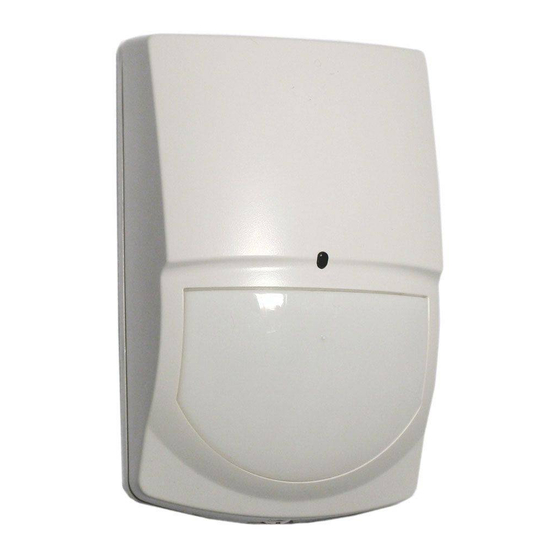Crow SWAN QUAD Petunjuk Instalasi
Jelajahi secara online atau unduh pdf Petunjuk Instalasi untuk Sensor Keamanan Crow SWAN QUAD. Crow SWAN QUAD 2 halaman. Pir motion detector with pet immunity up to 25 kg
Juga untuk Crow SWAN QUAD: Petunjuk Instalasi (2 halaman)

S W A N Q U A D
PIR MOTION DETECTOR With PET IMMUNITY up to 25 kg
PRODUCT FEATURES
The SWAN QUAD detector uses a special
designed optical Lens with unique Quad (Four
element) PIR Sensor and new ASIC based
electronics optimized to eliminate false alarms,
caused by small animals and Pets.
The SWAN QUAD provides unprecedented levels
of immunity against visible light.
The Detector offers an exceptional level of
detection capability and stability for every security
installation.
The SWAN QUAD is supplied with a Wide Angle
lens.
•
Quad Linear Imaging Technology for sharp
analysis of body dimensions and differentiation
from background and animals.
•
ASIC based electronics.
•
Immunity to animals up to 25kg.
•
18m Detection Range with Wide Angle Lens.
•
Temperature compensation.
•
Compact Design for Residential Installation.
•
Variable pulse width adjustment.
•
Sensitivity adjustment.
•
Environmental immunity.
•
Height installation calibration free
(1.8m – 2.4m).
•
LED Remote function.
SELECT MOUNTING LOCATION
Choose a location most likely to intercept an intruder.
(Our recommendation is a corner installation). See
detection pattern fig.3. The quad-element high quality
sensor detects motion crossing the beam; it is slightly
less sensitive detecting motion toward the detector.
The SWAN quad performs best when provided with a
constant and stable environment and background.
AVOID THE FOLLOWING LOCATIONS
• Facing direct sunlight.
• Facing areas that may change temperature
rapidly.
• Areas where there are air ducts or substantial
airflows.
WIRE SIZE REQUIREMENTS
Use #22 AWG (0.5 mm) or wires with a larger
diameter. Use the following table to determine the
required wire gauge (diameter) depending on the
length of wire between the detector and the control
panel.
Wire Length
m 200
300
Wire Diameter mm .5
.75
Wire Length
ft. 800 1200
Wire Gauge
#
22
20
P/N 7101570 REV. A Y.S - A.Y.
DETECTOR INSTALLATION
The detector can either be wall or corner mounted.
If ceiling or special wall mounting is required, use the
optional bracket base. Refer to bracket description.
(See fig. 6).
1. To remove the front cover, unscrew the holding screw
and gently raise the front cover.
2. To remove the PC board, carefully unscrew the
holding screw located on the PC board.
3. Break out the desired holes for proper installation.
A
C
B
C
B
4. The circular and rectangular indentations at the
bottom base are the knockout holes for wire entry.
You may also use mounting holes that are not in use
for running the wiring into the detector. (For Bracket
option - lead wire through the bracket)
5. Mount the detector base to the wall, corner or ceiling.
(For bracket installation option see fig. 6).
400
800
6. Reinstall the PC board by fully tightening the holding
1.0
1.5
screw. Connect wire to terminal block.
2000
3400
18
16
7. Replace the cover by inserting it back in the
appropriate closing pins and screw in the holding
screw.
Fig.3
Holding screw
Fig.1
A
A
A. Wire access holes
D
C
B. Use for flat wall
B
mounting
C. Corner mounting -
use all 4 holes.
Sharp left or right
angle mounting -
use 2 holes (top
and bottom)
D. For bracket
B
C
mounting
Fig.2
- 1 -
INSTALLATION INSTRUCTIONS
DETECTOR CONNECTION
1
2
3
4
5
Terminal 1 - Marked " - " (GND)
Connect to the negative Voltage Supply or ground of
the control panel.
Terminal 2 - Marked " + " (+12V)
Connect to a positive Voltage Supply of 8.2 -16Vdc
source (usually from the alarm control unit)
Terminals 3 & 6 - Marked " EOL " – End of line option.
Terminals 4 & 5 - Marked " TAMPER "
If a Tamper function is required connect these
terminals to a 24-hour normally closed protective zone
in the control unit. If the front cover of the detector is
opened, an immediate alarm signal will be sent to the
control unit.
Terminals 7 & 8 - Marked " RELAY "
These are the output relay contacts of the detector.
Connect to a normally closed zone in the control panel.
TESTING THE DETECTOR
Wait one minute after applying 12 Vdc power for warm
up time. Conduct testing with the protected area cleared
of all people.
Walk test
1. Remove front cover.
2. Set LED to ON position.
3. Reassemble the front cover.
4. Start walking slowly across the detection zone.
5. Observe that the LED lights whenever motion is
detected.
6. Allow 5 sec. between each test for the detector to
stabilize.
7. After the walk test is completed, you can set the
LED to OFF position.
NOTE:
Walk tests should be conducted, at least once a year,
to confirm proper operation and coverage of the
detector.
Fig.4
6
7
8
